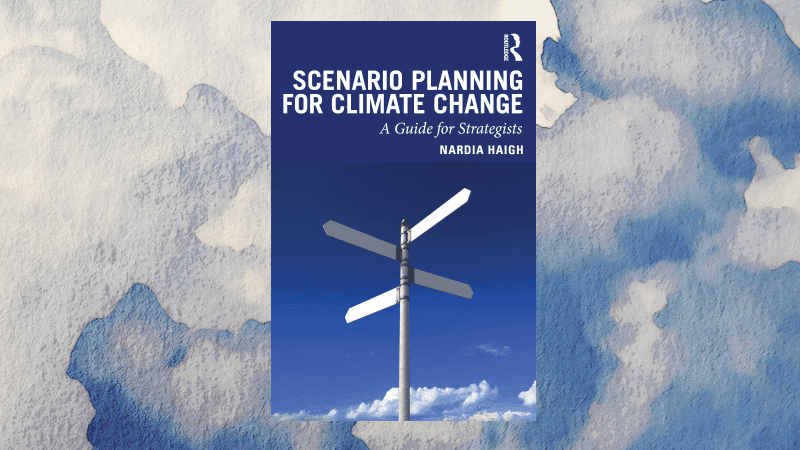In an age of surprising and devastating climatic trends and events, the need for scenario planning to develop climate change strategies has never been greater. But the prospect of starting scenario planning for climate change can be overwhelming. Previous work on the topic of scenario planning has often focused on large, well-known companies and consulting houses that have a wealth of in-house knowledge about and experience with scenario planning. Similarly, much climate change research has been conducted using samples of large companies.
This week’s featured book, however, shares insights about scenario planning and strategizing for climate change to help smooth this process, making it more accessible to all organizations, with practical step-by-step methods that managers in any organization could use to put together a scenario planning project to develop a climate change strategy.
About the Book
Climate change, and the resultant impact on resource management and societal well-being, is one of the greatest challenges facing businesses and their long-term performance. Uncertainty about access to resources, unanticipated weather events, policy changes, rapidly changing market conditions and potential social unrest is felt across all business and industry sectors.
Most climate change strategy books focus on climate mitigation, addressing how companies can engage with carbon policy, new technologies, markets and other stakeholders about reducing carbon emissions. This book explores these themes as well as strategizing for climate change adaptation, which is equally important, because organizations cannot negotiate with nature. It sets out an engaging step-by-step scenario planning method that executives, board members, managers and consultants alike can follow to develop a long-term strategy for climate change tailored for their business.
This book will help you interpret climate science for business in a way that acknowledges the realities of climate change, and help build the skills to identify ways forward that embrace the uncertainty.
Meet the Author

Nardia Haigh is a business strategist for sustainability issues. For nearly fifteen years, she has been working at the intersection of climate change and strategy. She has taught hundreds of executives and business students how to strategize for climate change resilience using scenario planning.
Nardia’s work appears in outlets including the California Management Review, Journal of Business Ethics, European Management Journal, Organization & Environment, and Business Strategy and the Environment. She has also been cited in media outlets such as the Guardian, Ideas for Leaders, PBS Newshour, and Management INK. Her straight-forward, step-by-step method is now available in her book, Scenario Planning for Climate Change.
Nardia earned her Ph.D. in Business Management at the University of Queensland Business School in Brisbane, Australia. As a doctoral student, she investigated organizational strategies in response to climate change issues. She is a tenured Associate Professor of Management at the University of Massachusetts Boston.
Praise from Readers Like You
“A useful step by step guide for all those who wish to manage climate change in their organization. Brings the daunting macro challenge down to helpful concrete steps.” —Christiana Figueres, Founding Partner of GlobalOptimism.com
“Climate change is the ultimate systems thinking challenge. We should be thinking about how climate change is going to affect our communities, businesses, operations and missions. It’s high time we had a ‘how to’ guide for putting a strategic thinking hat on and tackling the unprecedented transformation we must undertake to ensure health, security and economic vitality in a changing world.” —Daniel Kreeger, Executive Director, Association of Climate Change Officer
“The need for scenario planning has never been greater. The January 2019 PG&E bankruptcy was described by The Wall Street Journal as ‘the first major corporate casualty of climate change.’ The same week, David Crane, former utility CEO, said that within two decades Amazon or Google will dominate electricity provision in the U.S. Haigh provides a valuable resource for climate strategists.” —Gib Hedstrom, Author, Sustainability: What It Is and How to Measure It
“Climate related risks and transitions involve large uncertainties and long timeframes that are not often addressed with conventional strategic planning. The book offers a comprehensive, step-by-step process with helpful lists and tables to plan for an uncertain future. Leading an organization through the scenario planning process will not only result in a sound plan, but will increase management’s understanding of the best ways to respond to potential impacts of climate change.” —David Clark, Vice President, Sustainability, Amcor
Learn More
- Visit Amazon to buy a copy of the book, or leave a short review of it.
- Check out the website for a free chapter and ways to support the book.

Elizabeth Johnson loves the color yellow, strong {black} coffee, editing, and exploring the mountains in rural Wyoming and Utah, where she and her husband serve as church planters. In her free time, she enjoys learning new things, hand-lettering and acrylic painting, and gaming with her husband.

